Human Resource Management Research
VerifiedAdded on 2020/04/21
|22
|4296
|145
AI Summary
This assignment delves into a comprehensive 40-year meta-analysis examining the performance of human resource management (HRM) practices. It requires students to analyze research findings on various HRM aspects, including employee engagement, motivation, recruitment, and organizational effectiveness. The analysis should consider influential theories like Maslow's hierarchy of needs and Herzberg's dual factor theory, alongside contemporary trends in HRM such as technology's impact and the changing nature of work.
Contribute Materials
Your contribution can guide someone’s learning journey. Share your
documents today.
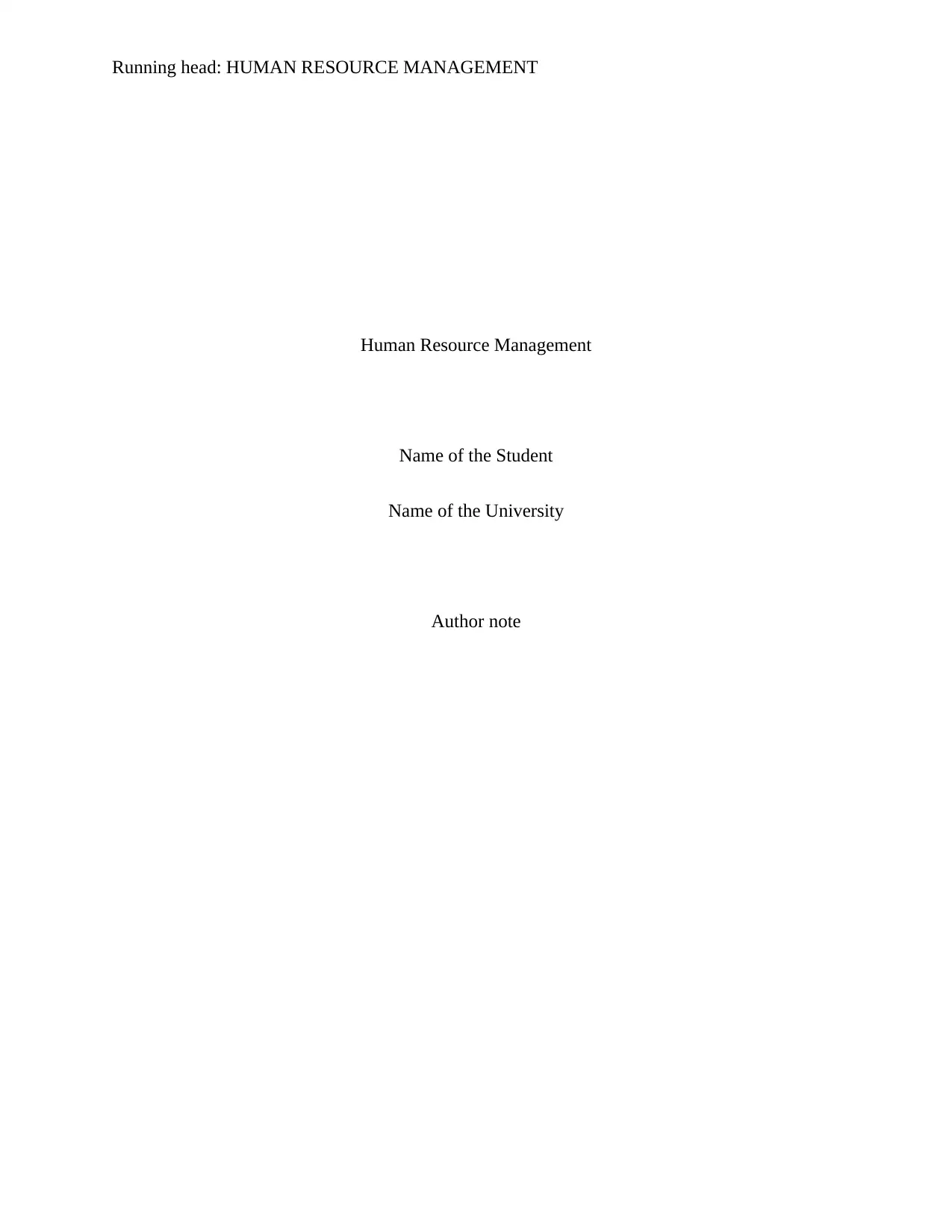
Running head: HUMAN RESOURCE MANAGEMENT
Human Resource Management
Name of the Student
Name of the University
Author note
Human Resource Management
Name of the Student
Name of the University
Author note
Secure Best Marks with AI Grader
Need help grading? Try our AI Grader for instant feedback on your assignments.
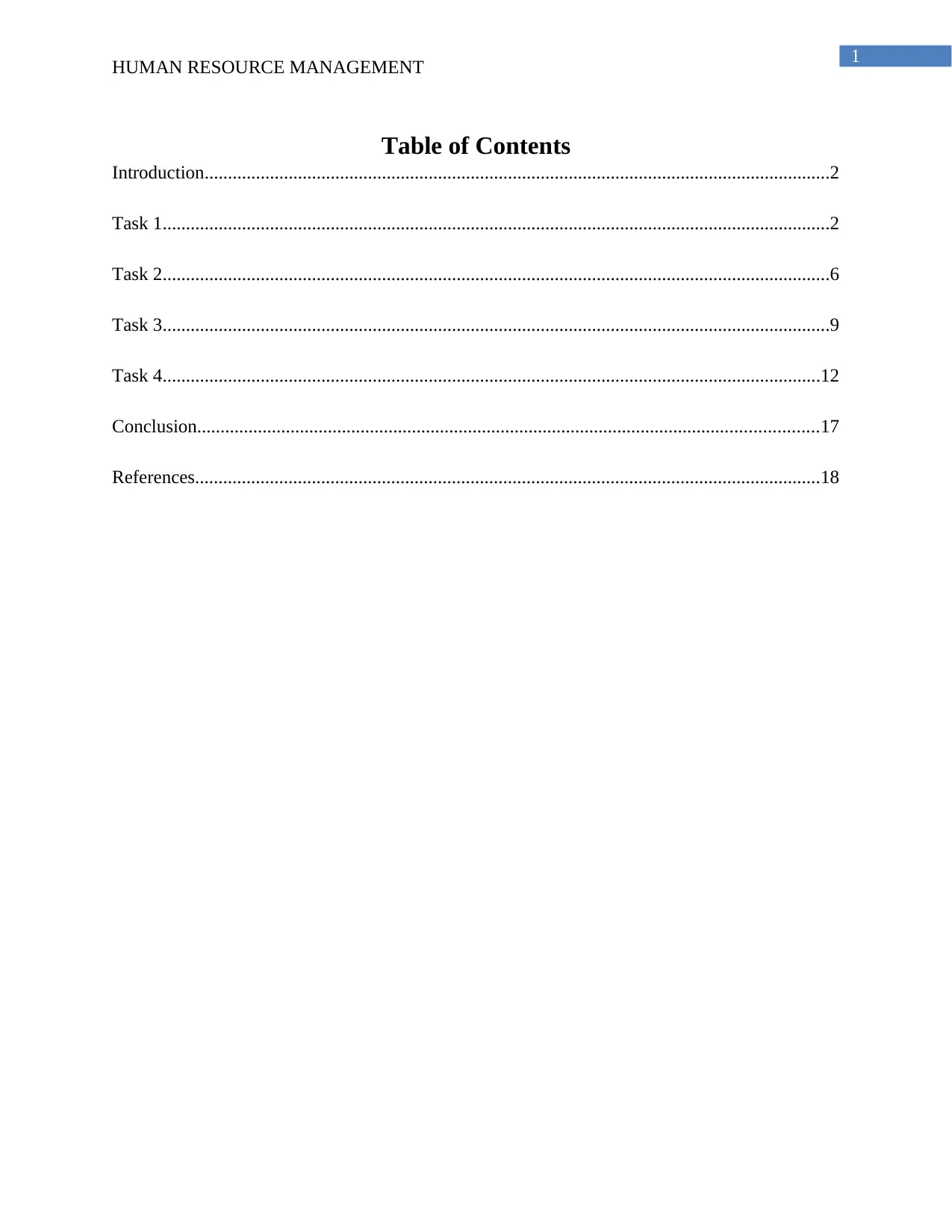
1
HUMAN RESOURCE MANAGEMENT
Table of Contents
Introduction......................................................................................................................................2
Task 1...............................................................................................................................................2
Task 2...............................................................................................................................................6
Task 3...............................................................................................................................................9
Task 4.............................................................................................................................................12
Conclusion.....................................................................................................................................17
References......................................................................................................................................18
HUMAN RESOURCE MANAGEMENT
Table of Contents
Introduction......................................................................................................................................2
Task 1...............................................................................................................................................2
Task 2...............................................................................................................................................6
Task 3...............................................................................................................................................9
Task 4.............................................................................................................................................12
Conclusion.....................................................................................................................................17
References......................................................................................................................................18
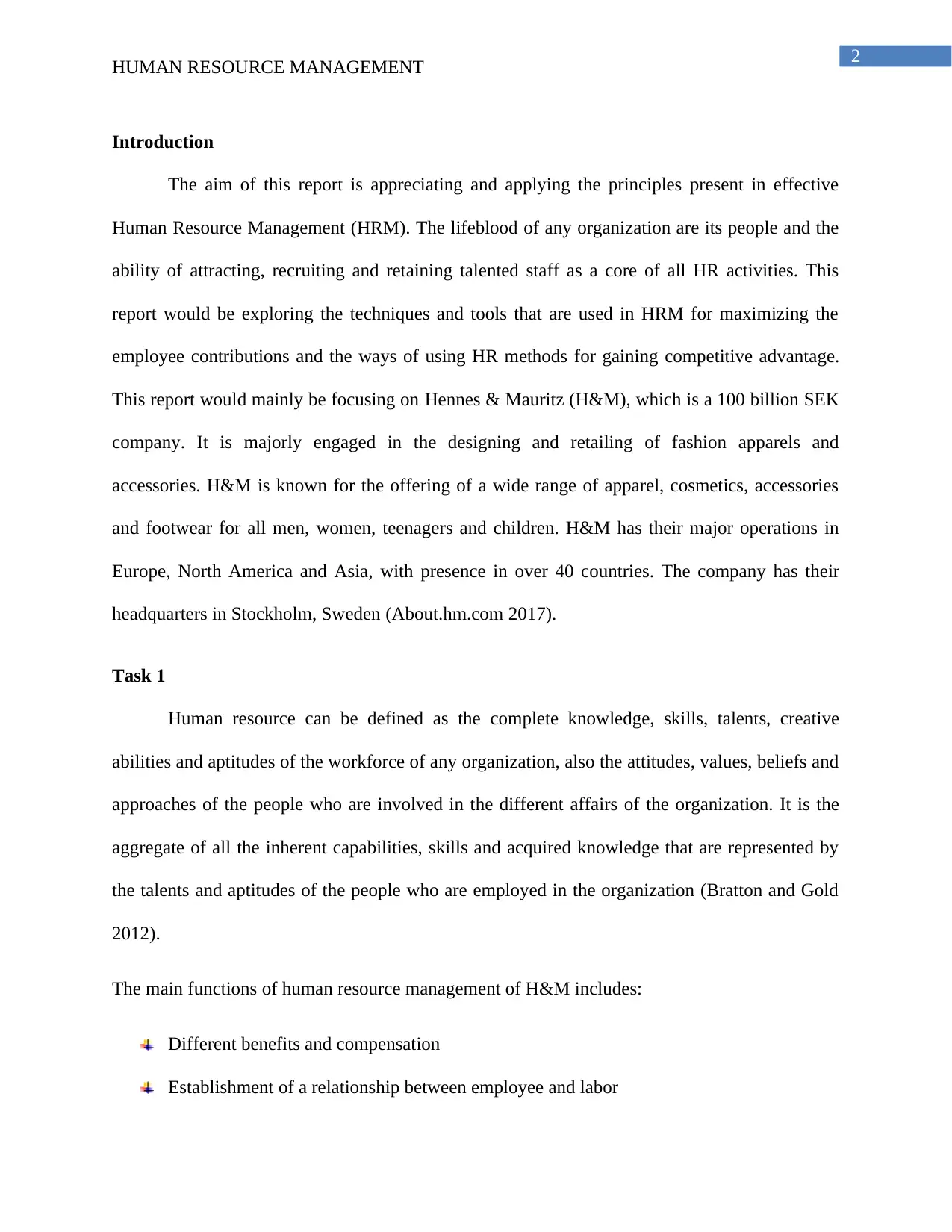
2
HUMAN RESOURCE MANAGEMENT
Introduction
The aim of this report is appreciating and applying the principles present in effective
Human Resource Management (HRM). The lifeblood of any organization are its people and the
ability of attracting, recruiting and retaining talented staff as a core of all HR activities. This
report would be exploring the techniques and tools that are used in HRM for maximizing the
employee contributions and the ways of using HR methods for gaining competitive advantage.
This report would mainly be focusing on Hennes & Mauritz (H&M), which is a 100 billion SEK
company. It is majorly engaged in the designing and retailing of fashion apparels and
accessories. H&M is known for the offering of a wide range of apparel, cosmetics, accessories
and footwear for all men, women, teenagers and children. H&M has their major operations in
Europe, North America and Asia, with presence in over 40 countries. The company has their
headquarters in Stockholm, Sweden (About.hm.com 2017).
Task 1
Human resource can be defined as the complete knowledge, skills, talents, creative
abilities and aptitudes of the workforce of any organization, also the attitudes, values, beliefs and
approaches of the people who are involved in the different affairs of the organization. It is the
aggregate of all the inherent capabilities, skills and acquired knowledge that are represented by
the talents and aptitudes of the people who are employed in the organization (Bratton and Gold
2012).
The main functions of human resource management of H&M includes:
Different benefits and compensation
Establishment of a relationship between employee and labor
HUMAN RESOURCE MANAGEMENT
Introduction
The aim of this report is appreciating and applying the principles present in effective
Human Resource Management (HRM). The lifeblood of any organization are its people and the
ability of attracting, recruiting and retaining talented staff as a core of all HR activities. This
report would be exploring the techniques and tools that are used in HRM for maximizing the
employee contributions and the ways of using HR methods for gaining competitive advantage.
This report would mainly be focusing on Hennes & Mauritz (H&M), which is a 100 billion SEK
company. It is majorly engaged in the designing and retailing of fashion apparels and
accessories. H&M is known for the offering of a wide range of apparel, cosmetics, accessories
and footwear for all men, women, teenagers and children. H&M has their major operations in
Europe, North America and Asia, with presence in over 40 countries. The company has their
headquarters in Stockholm, Sweden (About.hm.com 2017).
Task 1
Human resource can be defined as the complete knowledge, skills, talents, creative
abilities and aptitudes of the workforce of any organization, also the attitudes, values, beliefs and
approaches of the people who are involved in the different affairs of the organization. It is the
aggregate of all the inherent capabilities, skills and acquired knowledge that are represented by
the talents and aptitudes of the people who are employed in the organization (Bratton and Gold
2012).
The main functions of human resource management of H&M includes:
Different benefits and compensation
Establishment of a relationship between employee and labor

3
HUMAN RESOURCE MANAGEMENT
Development of the different human resource practices
Execution of human resource planning, recruitment and selection
Conducting proper human resource research
Maintaining proper organizational safety and health (Beardwell and Thompson 2014)
The main activities of human resource management (HRM) of H&M includes:
Development of the complete knowledge regarding the culture, corporate plans along
with the different policies of H&M
Training and development of the staff
Performance appraisal of the employees
Collective bargaining, grievance handling and contract negotiation
Assisting in the self-development of the employees at all organizational levels
Development and maintenance of motivation for workers by the providing of incentives
Review and audit of manpower management in the organization
Extensive role analysis for job occupants
Job rotation
Quality circle, quality of work life and organizational development
Establishment of better communication among every individual who are present inside
the workplace of H&M (Aswathappa 2013)
Inside HRM, there are two approaches, the best fit and the best practice:
The best practice – Best practice approach states that different HR policies would be consisting
of reward plans. Inside this practice, the HR directs to improved commitment of the employees
along with high motivation for the same (Buller and McEvoy 2012).
HUMAN RESOURCE MANAGEMENT
Development of the different human resource practices
Execution of human resource planning, recruitment and selection
Conducting proper human resource research
Maintaining proper organizational safety and health (Beardwell and Thompson 2014)
The main activities of human resource management (HRM) of H&M includes:
Development of the complete knowledge regarding the culture, corporate plans along
with the different policies of H&M
Training and development of the staff
Performance appraisal of the employees
Collective bargaining, grievance handling and contract negotiation
Assisting in the self-development of the employees at all organizational levels
Development and maintenance of motivation for workers by the providing of incentives
Review and audit of manpower management in the organization
Extensive role analysis for job occupants
Job rotation
Quality circle, quality of work life and organizational development
Establishment of better communication among every individual who are present inside
the workplace of H&M (Aswathappa 2013)
Inside HRM, there are two approaches, the best fit and the best practice:
The best practice – Best practice approach states that different HR policies would be consisting
of reward plans. Inside this practice, the HR directs to improved commitment of the employees
along with high motivation for the same (Buller and McEvoy 2012).
Secure Best Marks with AI Grader
Need help grading? Try our AI Grader for instant feedback on your assignments.
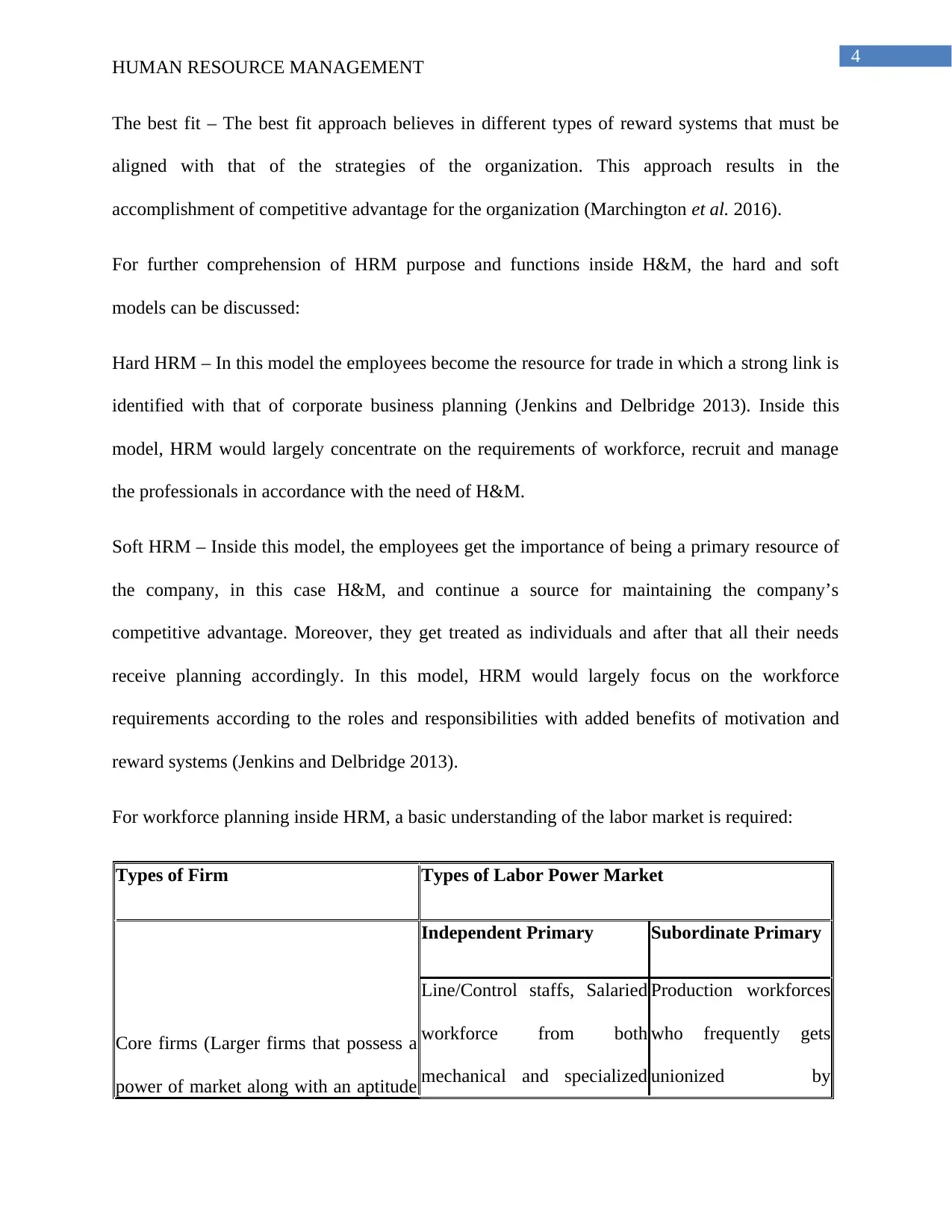
4
HUMAN RESOURCE MANAGEMENT
The best fit – The best fit approach believes in different types of reward systems that must be
aligned with that of the strategies of the organization. This approach results in the
accomplishment of competitive advantage for the organization (Marchington et al. 2016).
For further comprehension of HRM purpose and functions inside H&M, the hard and soft
models can be discussed:
Hard HRM – In this model the employees become the resource for trade in which a strong link is
identified with that of corporate business planning (Jenkins and Delbridge 2013). Inside this
model, HRM would largely concentrate on the requirements of workforce, recruit and manage
the professionals in accordance with the need of H&M.
Soft HRM – Inside this model, the employees get the importance of being a primary resource of
the company, in this case H&M, and continue a source for maintaining the company’s
competitive advantage. Moreover, they get treated as individuals and after that all their needs
receive planning accordingly. In this model, HRM would largely focus on the workforce
requirements according to the roles and responsibilities with added benefits of motivation and
reward systems (Jenkins and Delbridge 2013).
For workforce planning inside HRM, a basic understanding of the labor market is required:
Types of Firm Types of Labor Power Market
Core firms (Larger firms that possess a
power of market along with an aptitude
Independent Primary Subordinate Primary
Line/Control staffs, Salaried
workforce from both
mechanical and specialized
Production workforces
who frequently gets
unionized by
HUMAN RESOURCE MANAGEMENT
The best fit – The best fit approach believes in different types of reward systems that must be
aligned with that of the strategies of the organization. This approach results in the
accomplishment of competitive advantage for the organization (Marchington et al. 2016).
For further comprehension of HRM purpose and functions inside H&M, the hard and soft
models can be discussed:
Hard HRM – In this model the employees become the resource for trade in which a strong link is
identified with that of corporate business planning (Jenkins and Delbridge 2013). Inside this
model, HRM would largely concentrate on the requirements of workforce, recruit and manage
the professionals in accordance with the need of H&M.
Soft HRM – Inside this model, the employees get the importance of being a primary resource of
the company, in this case H&M, and continue a source for maintaining the company’s
competitive advantage. Moreover, they get treated as individuals and after that all their needs
receive planning accordingly. In this model, HRM would largely focus on the workforce
requirements according to the roles and responsibilities with added benefits of motivation and
reward systems (Jenkins and Delbridge 2013).
For workforce planning inside HRM, a basic understanding of the labor market is required:
Types of Firm Types of Labor Power Market
Core firms (Larger firms that possess a
power of market along with an aptitude
Independent Primary Subordinate Primary
Line/Control staffs, Salaried
workforce from both
mechanical and specialized
Production workforces
who frequently gets
unionized by
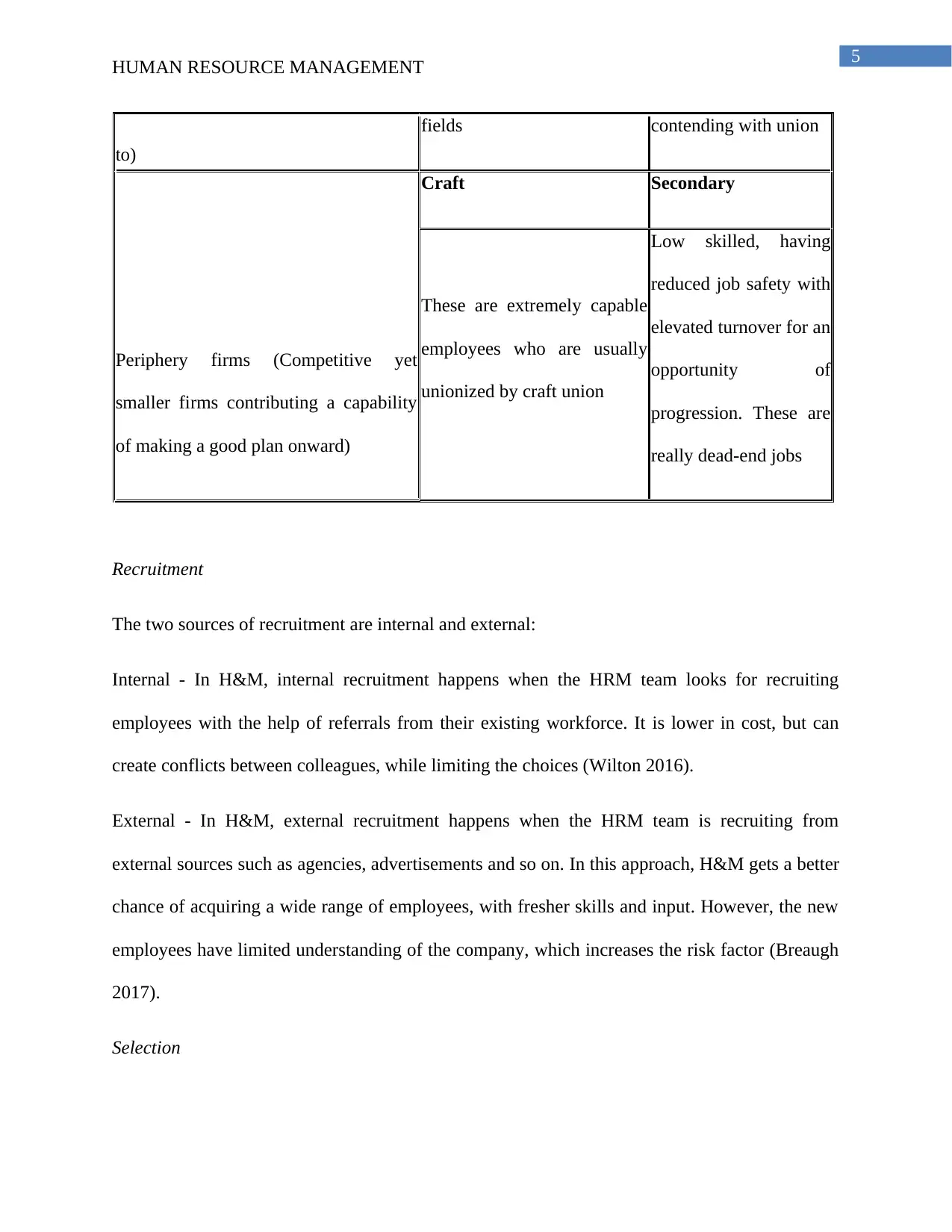
5
HUMAN RESOURCE MANAGEMENT
to)
fields contending with union
Periphery firms (Competitive yet
smaller firms contributing a capability
of making a good plan onward)
Craft Secondary
These are extremely capable
employees who are usually
unionized by craft union
Low skilled, having
reduced job safety with
elevated turnover for an
opportunity of
progression. These are
really dead-end jobs
Recruitment
The two sources of recruitment are internal and external:
Internal - In H&M, internal recruitment happens when the HRM team looks for recruiting
employees with the help of referrals from their existing workforce. It is lower in cost, but can
create conflicts between colleagues, while limiting the choices (Wilton 2016).
External - In H&M, external recruitment happens when the HRM team is recruiting from
external sources such as agencies, advertisements and so on. In this approach, H&M gets a better
chance of acquiring a wide range of employees, with fresher skills and input. However, the new
employees have limited understanding of the company, which increases the risk factor (Breaugh
2017).
Selection
HUMAN RESOURCE MANAGEMENT
to)
fields contending with union
Periphery firms (Competitive yet
smaller firms contributing a capability
of making a good plan onward)
Craft Secondary
These are extremely capable
employees who are usually
unionized by craft union
Low skilled, having
reduced job safety with
elevated turnover for an
opportunity of
progression. These are
really dead-end jobs
Recruitment
The two sources of recruitment are internal and external:
Internal - In H&M, internal recruitment happens when the HRM team looks for recruiting
employees with the help of referrals from their existing workforce. It is lower in cost, but can
create conflicts between colleagues, while limiting the choices (Wilton 2016).
External - In H&M, external recruitment happens when the HRM team is recruiting from
external sources such as agencies, advertisements and so on. In this approach, H&M gets a better
chance of acquiring a wide range of employees, with fresher skills and input. However, the new
employees have limited understanding of the company, which increases the risk factor (Breaugh
2017).
Selection

6
HUMAN RESOURCE MANAGEMENT
The main methods of selection are on-boarding and induction in which reliability and validity are
the key criteria. Successful induction and socialization of employees gets affected by certain
factors (Salau, Falola and Akinbode 2014).
Task 2
For evaluating the effectiveness of the different elements of human resource management
in H&M, the following assessments needs to be carried out:
Effectiveness of different training evaluation models:
At H&M, with evaluation, accountability is assured. The cost efficiency of the training programs
can be checked. Feedbacks are provided on the process of training as well as for the person
taking the training.
Effectiveness of job and workplace design, and reward system:
The job and workplace design, and the reward system at H&M enhances the following:
Increase in the productivity levels
Increase in attendance
Improvement in employee retention
Improvement in employee morale
Effectiveness of adaptable organization and adaptable working options:
The freshly implemented flexible work schedule at H&M would be helpful in
strengthening the employee commitments and help them in handling circumstances that may be
unsafe for the functionality of H&M. It actually inspired them to work perfectly for having a
positive impact over the outcome.
HUMAN RESOURCE MANAGEMENT
The main methods of selection are on-boarding and induction in which reliability and validity are
the key criteria. Successful induction and socialization of employees gets affected by certain
factors (Salau, Falola and Akinbode 2014).
Task 2
For evaluating the effectiveness of the different elements of human resource management
in H&M, the following assessments needs to be carried out:
Effectiveness of different training evaluation models:
At H&M, with evaluation, accountability is assured. The cost efficiency of the training programs
can be checked. Feedbacks are provided on the process of training as well as for the person
taking the training.
Effectiveness of job and workplace design, and reward system:
The job and workplace design, and the reward system at H&M enhances the following:
Increase in the productivity levels
Increase in attendance
Improvement in employee retention
Improvement in employee morale
Effectiveness of adaptable organization and adaptable working options:
The freshly implemented flexible work schedule at H&M would be helpful in
strengthening the employee commitments and help them in handling circumstances that may be
unsafe for the functionality of H&M. It actually inspired them to work perfectly for having a
positive impact over the outcome.
Paraphrase This Document
Need a fresh take? Get an instant paraphrase of this document with our AI Paraphraser
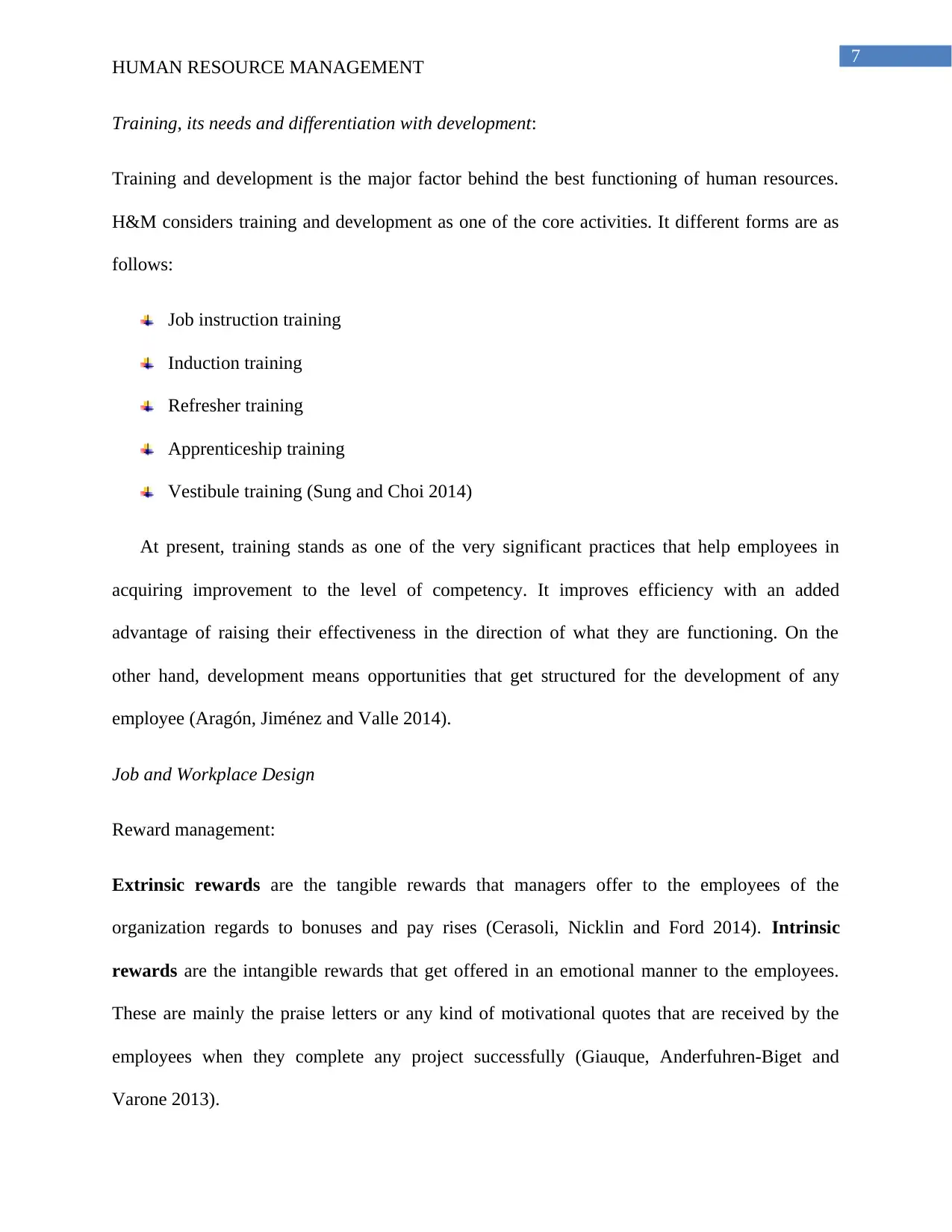
7
HUMAN RESOURCE MANAGEMENT
Training, its needs and differentiation with development:
Training and development is the major factor behind the best functioning of human resources.
H&M considers training and development as one of the core activities. It different forms are as
follows:
Job instruction training
Induction training
Refresher training
Apprenticeship training
Vestibule training (Sung and Choi 2014)
At present, training stands as one of the very significant practices that help employees in
acquiring improvement to the level of competency. It improves efficiency with an added
advantage of raising their effectiveness in the direction of what they are functioning. On the
other hand, development means opportunities that get structured for the development of any
employee (Aragón, Jiménez and Valle 2014).
Job and Workplace Design
Reward management:
Extrinsic rewards are the tangible rewards that managers offer to the employees of the
organization regards to bonuses and pay rises (Cerasoli, Nicklin and Ford 2014). Intrinsic
rewards are the intangible rewards that get offered in an emotional manner to the employees.
These are mainly the praise letters or any kind of motivational quotes that are received by the
employees when they complete any project successfully (Giauque, Anderfuhren-Biget and
Varone 2013).
HUMAN RESOURCE MANAGEMENT
Training, its needs and differentiation with development:
Training and development is the major factor behind the best functioning of human resources.
H&M considers training and development as one of the core activities. It different forms are as
follows:
Job instruction training
Induction training
Refresher training
Apprenticeship training
Vestibule training (Sung and Choi 2014)
At present, training stands as one of the very significant practices that help employees in
acquiring improvement to the level of competency. It improves efficiency with an added
advantage of raising their effectiveness in the direction of what they are functioning. On the
other hand, development means opportunities that get structured for the development of any
employee (Aragón, Jiménez and Valle 2014).
Job and Workplace Design
Reward management:
Extrinsic rewards are the tangible rewards that managers offer to the employees of the
organization regards to bonuses and pay rises (Cerasoli, Nicklin and Ford 2014). Intrinsic
rewards are the intangible rewards that get offered in an emotional manner to the employees.
These are mainly the praise letters or any kind of motivational quotes that are received by the
employees when they complete any project successfully (Giauque, Anderfuhren-Biget and
Varone 2013).
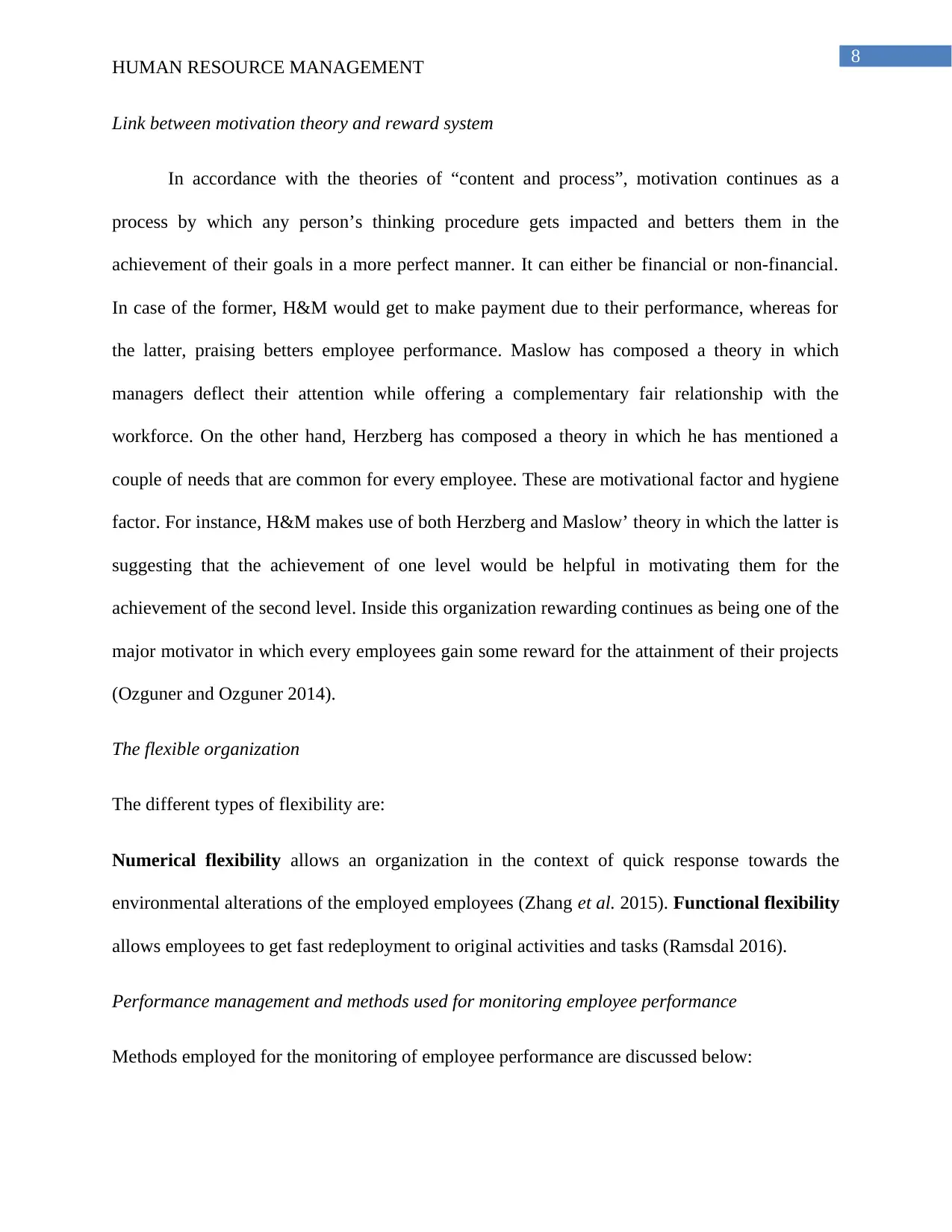
8
HUMAN RESOURCE MANAGEMENT
Link between motivation theory and reward system
In accordance with the theories of “content and process”, motivation continues as a
process by which any person’s thinking procedure gets impacted and betters them in the
achievement of their goals in a more perfect manner. It can either be financial or non-financial.
In case of the former, H&M would get to make payment due to their performance, whereas for
the latter, praising betters employee performance. Maslow has composed a theory in which
managers deflect their attention while offering a complementary fair relationship with the
workforce. On the other hand, Herzberg has composed a theory in which he has mentioned a
couple of needs that are common for every employee. These are motivational factor and hygiene
factor. For instance, H&M makes use of both Herzberg and Maslow’ theory in which the latter is
suggesting that the achievement of one level would be helpful in motivating them for the
achievement of the second level. Inside this organization rewarding continues as being one of the
major motivator in which every employees gain some reward for the attainment of their projects
(Ozguner and Ozguner 2014).
The flexible organization
The different types of flexibility are:
Numerical flexibility allows an organization in the context of quick response towards the
environmental alterations of the employed employees (Zhang et al. 2015). Functional flexibility
allows employees to get fast redeployment to original activities and tasks (Ramsdal 2016).
Performance management and methods used for monitoring employee performance
Methods employed for the monitoring of employee performance are discussed below:
HUMAN RESOURCE MANAGEMENT
Link between motivation theory and reward system
In accordance with the theories of “content and process”, motivation continues as a
process by which any person’s thinking procedure gets impacted and betters them in the
achievement of their goals in a more perfect manner. It can either be financial or non-financial.
In case of the former, H&M would get to make payment due to their performance, whereas for
the latter, praising betters employee performance. Maslow has composed a theory in which
managers deflect their attention while offering a complementary fair relationship with the
workforce. On the other hand, Herzberg has composed a theory in which he has mentioned a
couple of needs that are common for every employee. These are motivational factor and hygiene
factor. For instance, H&M makes use of both Herzberg and Maslow’ theory in which the latter is
suggesting that the achievement of one level would be helpful in motivating them for the
achievement of the second level. Inside this organization rewarding continues as being one of the
major motivator in which every employees gain some reward for the attainment of their projects
(Ozguner and Ozguner 2014).
The flexible organization
The different types of flexibility are:
Numerical flexibility allows an organization in the context of quick response towards the
environmental alterations of the employed employees (Zhang et al. 2015). Functional flexibility
allows employees to get fast redeployment to original activities and tasks (Ramsdal 2016).
Performance management and methods used for monitoring employee performance
Methods employed for the monitoring of employee performance are discussed below:

9
HUMAN RESOURCE MANAGEMENT
For keeping a track of what the employees are doing, employees are regularly asked
about what tools they are using for self-monitoring.
Regularly keeping track of the employee performance and the way they are achieving
their regular tasks
Monitoring employee performance by record tracking from previous performance, also
becoming aware regarding different means used for functioning.
Task 3
At H&M, huge importance is provided to maintaining personality and developing
opportunity for the employees to be growing inside the organization. Different practices
empower the employees, which in turn encourages team work, gives backing to efficient
leadership and presents with sufficient growth opportunities for the employees.
By means of employee relations the management maintains their interaction and
addresses every employee. Properly maintaining a good relationship would help in the reduction
of any form of workplace conflicts along with some additional advantages like improving staff
morale and increasing the productivity of the whole organization (Shields et al. 2015). At H&M,
the various ways that are put to use for bettering of this has been discussed below:
Better communication: While taking care of the maintenance of proper hierarchy, the
management ensures that every employee is having admittance to every level so that they feels
the priority of their service along with their significance inside the organization.
Career development: For reducing employee turnover, H&M have made sure to adopt some
roles related to the development of staff career.
HUMAN RESOURCE MANAGEMENT
For keeping a track of what the employees are doing, employees are regularly asked
about what tools they are using for self-monitoring.
Regularly keeping track of the employee performance and the way they are achieving
their regular tasks
Monitoring employee performance by record tracking from previous performance, also
becoming aware regarding different means used for functioning.
Task 3
At H&M, huge importance is provided to maintaining personality and developing
opportunity for the employees to be growing inside the organization. Different practices
empower the employees, which in turn encourages team work, gives backing to efficient
leadership and presents with sufficient growth opportunities for the employees.
By means of employee relations the management maintains their interaction and
addresses every employee. Properly maintaining a good relationship would help in the reduction
of any form of workplace conflicts along with some additional advantages like improving staff
morale and increasing the productivity of the whole organization (Shields et al. 2015). At H&M,
the various ways that are put to use for bettering of this has been discussed below:
Better communication: While taking care of the maintenance of proper hierarchy, the
management ensures that every employee is having admittance to every level so that they feels
the priority of their service along with their significance inside the organization.
Career development: For reducing employee turnover, H&M have made sure to adopt some
roles related to the development of staff career.
Secure Best Marks with AI Grader
Need help grading? Try our AI Grader for instant feedback on your assignments.
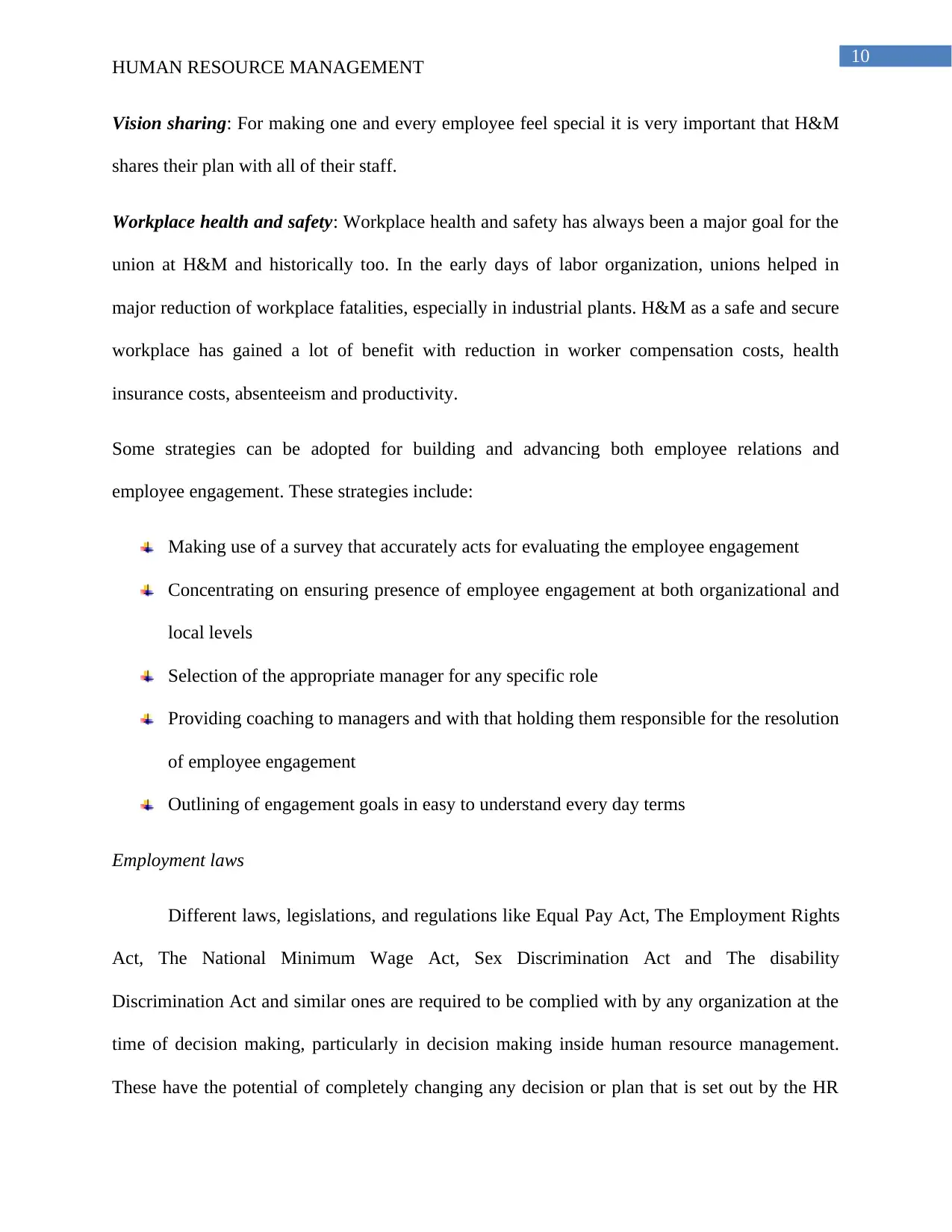
10
HUMAN RESOURCE MANAGEMENT
Vision sharing: For making one and every employee feel special it is very important that H&M
shares their plan with all of their staff.
Workplace health and safety: Workplace health and safety has always been a major goal for the
union at H&M and historically too. In the early days of labor organization, unions helped in
major reduction of workplace fatalities, especially in industrial plants. H&M as a safe and secure
workplace has gained a lot of benefit with reduction in worker compensation costs, health
insurance costs, absenteeism and productivity.
Some strategies can be adopted for building and advancing both employee relations and
employee engagement. These strategies include:
Making use of a survey that accurately acts for evaluating the employee engagement
Concentrating on ensuring presence of employee engagement at both organizational and
local levels
Selection of the appropriate manager for any specific role
Providing coaching to managers and with that holding them responsible for the resolution
of employee engagement
Outlining of engagement goals in easy to understand every day terms
Employment laws
Different laws, legislations, and regulations like Equal Pay Act, The Employment Rights
Act, The National Minimum Wage Act, Sex Discrimination Act and The disability
Discrimination Act and similar ones are required to be complied with by any organization at the
time of decision making, particularly in decision making inside human resource management.
These have the potential of completely changing any decision or plan that is set out by the HR
HUMAN RESOURCE MANAGEMENT
Vision sharing: For making one and every employee feel special it is very important that H&M
shares their plan with all of their staff.
Workplace health and safety: Workplace health and safety has always been a major goal for the
union at H&M and historically too. In the early days of labor organization, unions helped in
major reduction of workplace fatalities, especially in industrial plants. H&M as a safe and secure
workplace has gained a lot of benefit with reduction in worker compensation costs, health
insurance costs, absenteeism and productivity.
Some strategies can be adopted for building and advancing both employee relations and
employee engagement. These strategies include:
Making use of a survey that accurately acts for evaluating the employee engagement
Concentrating on ensuring presence of employee engagement at both organizational and
local levels
Selection of the appropriate manager for any specific role
Providing coaching to managers and with that holding them responsible for the resolution
of employee engagement
Outlining of engagement goals in easy to understand every day terms
Employment laws
Different laws, legislations, and regulations like Equal Pay Act, The Employment Rights
Act, The National Minimum Wage Act, Sex Discrimination Act and The disability
Discrimination Act and similar ones are required to be complied with by any organization at the
time of decision making, particularly in decision making inside human resource management.
These have the potential of completely changing any decision or plan that is set out by the HR
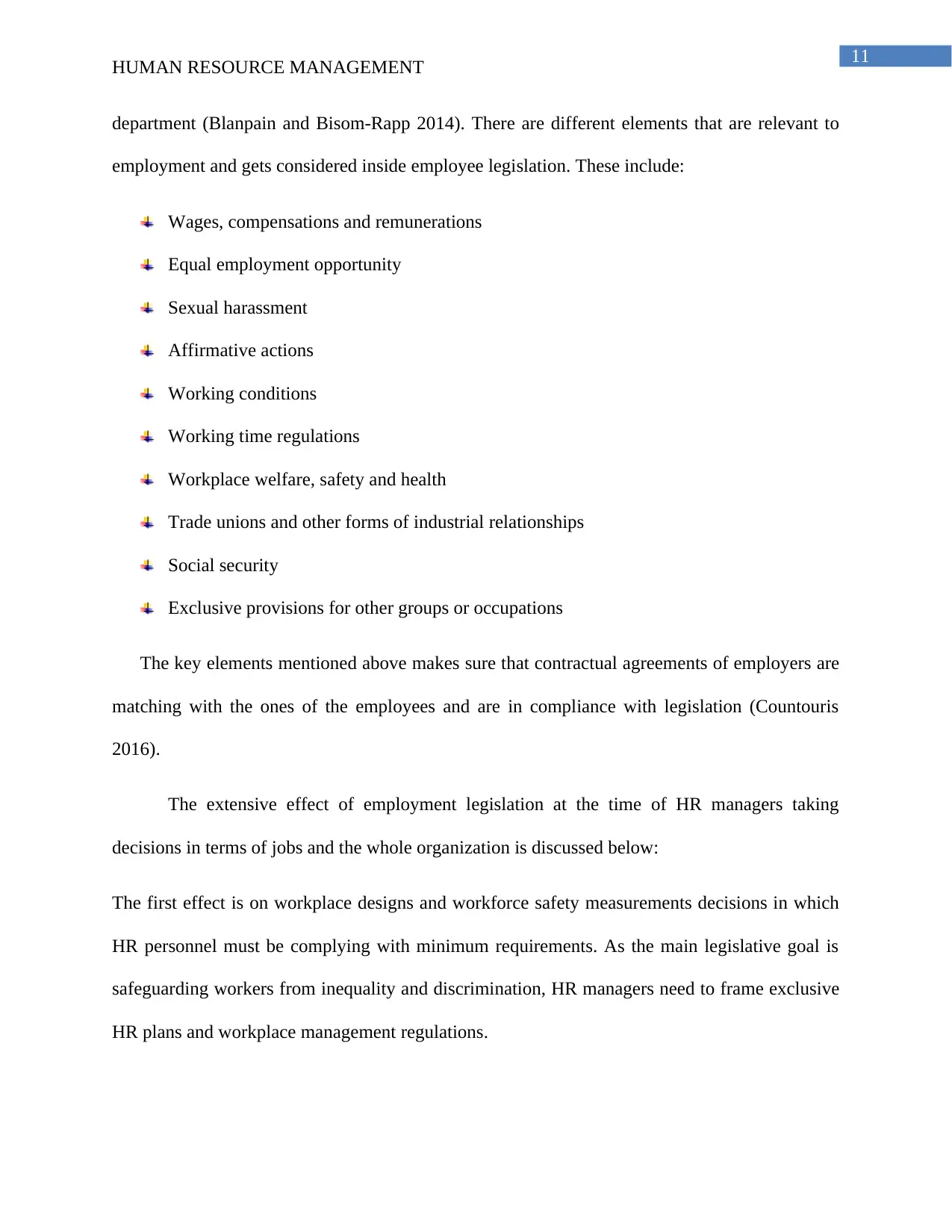
11
HUMAN RESOURCE MANAGEMENT
department (Blanpain and Bisom-Rapp 2014). There are different elements that are relevant to
employment and gets considered inside employee legislation. These include:
Wages, compensations and remunerations
Equal employment opportunity
Sexual harassment
Affirmative actions
Working conditions
Working time regulations
Workplace welfare, safety and health
Trade unions and other forms of industrial relationships
Social security
Exclusive provisions for other groups or occupations
The key elements mentioned above makes sure that contractual agreements of employers are
matching with the ones of the employees and are in compliance with legislation (Countouris
2016).
The extensive effect of employment legislation at the time of HR managers taking
decisions in terms of jobs and the whole organization is discussed below:
The first effect is on workplace designs and workforce safety measurements decisions in which
HR personnel must be complying with minimum requirements. As the main legislative goal is
safeguarding workers from inequality and discrimination, HR managers need to frame exclusive
HR plans and workplace management regulations.
HUMAN RESOURCE MANAGEMENT
department (Blanpain and Bisom-Rapp 2014). There are different elements that are relevant to
employment and gets considered inside employee legislation. These include:
Wages, compensations and remunerations
Equal employment opportunity
Sexual harassment
Affirmative actions
Working conditions
Working time regulations
Workplace welfare, safety and health
Trade unions and other forms of industrial relationships
Social security
Exclusive provisions for other groups or occupations
The key elements mentioned above makes sure that contractual agreements of employers are
matching with the ones of the employees and are in compliance with legislation (Countouris
2016).
The extensive effect of employment legislation at the time of HR managers taking
decisions in terms of jobs and the whole organization is discussed below:
The first effect is on workplace designs and workforce safety measurements decisions in which
HR personnel must be complying with minimum requirements. As the main legislative goal is
safeguarding workers from inequality and discrimination, HR managers need to frame exclusive
HR plans and workplace management regulations.
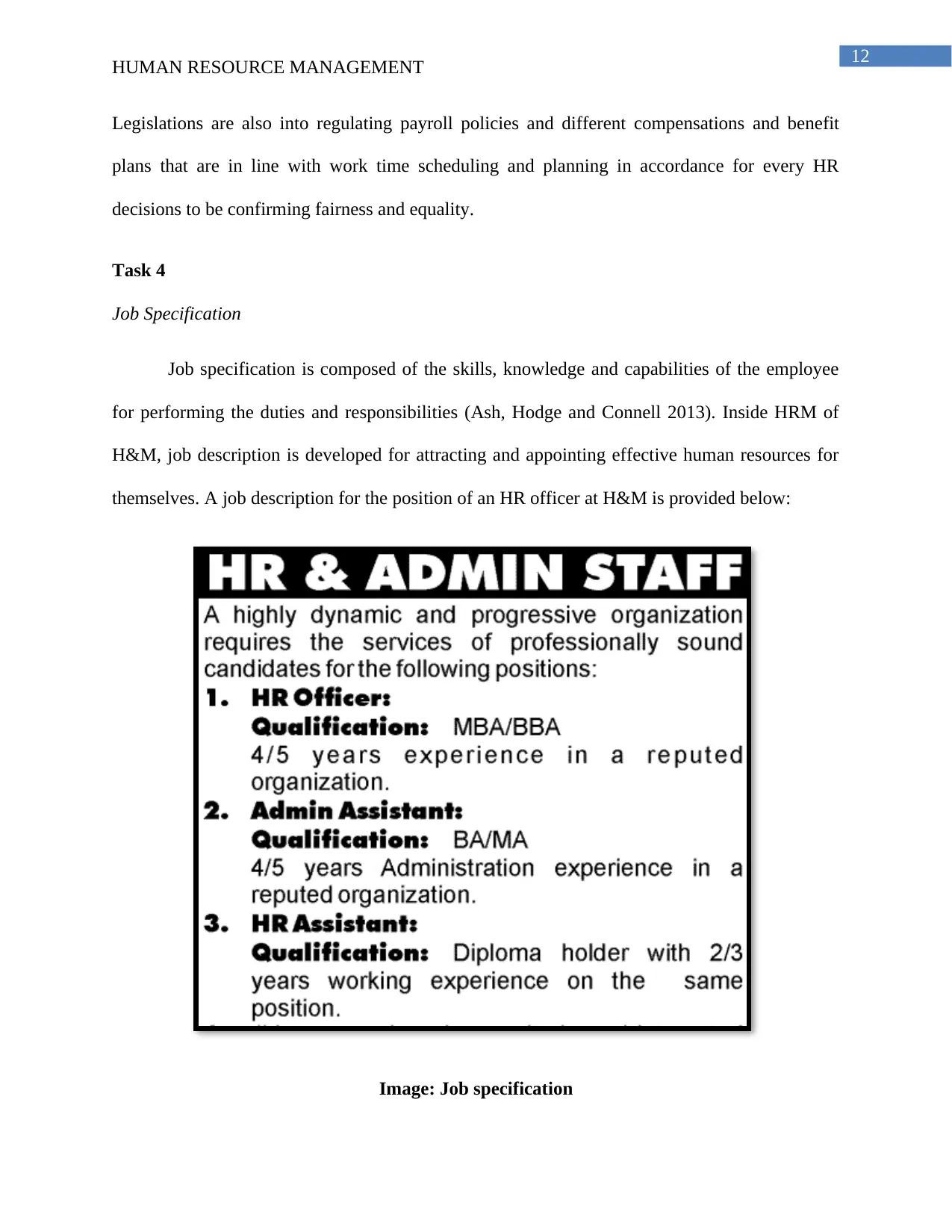
12
HUMAN RESOURCE MANAGEMENT
Legislations are also into regulating payroll policies and different compensations and benefit
plans that are in line with work time scheduling and planning in accordance for every HR
decisions to be confirming fairness and equality.
Task 4
Job Specification
Job specification is composed of the skills, knowledge and capabilities of the employee
for performing the duties and responsibilities (Ash, Hodge and Connell 2013). Inside HRM of
H&M, job description is developed for attracting and appointing effective human resources for
themselves. A job description for the position of an HR officer at H&M is provided below:
Image: Job specification
HUMAN RESOURCE MANAGEMENT
Legislations are also into regulating payroll policies and different compensations and benefit
plans that are in line with work time scheduling and planning in accordance for every HR
decisions to be confirming fairness and equality.
Task 4
Job Specification
Job specification is composed of the skills, knowledge and capabilities of the employee
for performing the duties and responsibilities (Ash, Hodge and Connell 2013). Inside HRM of
H&M, job description is developed for attracting and appointing effective human resources for
themselves. A job description for the position of an HR officer at H&M is provided below:
Image: Job specification
Paraphrase This Document
Need a fresh take? Get an instant paraphrase of this document with our AI Paraphraser
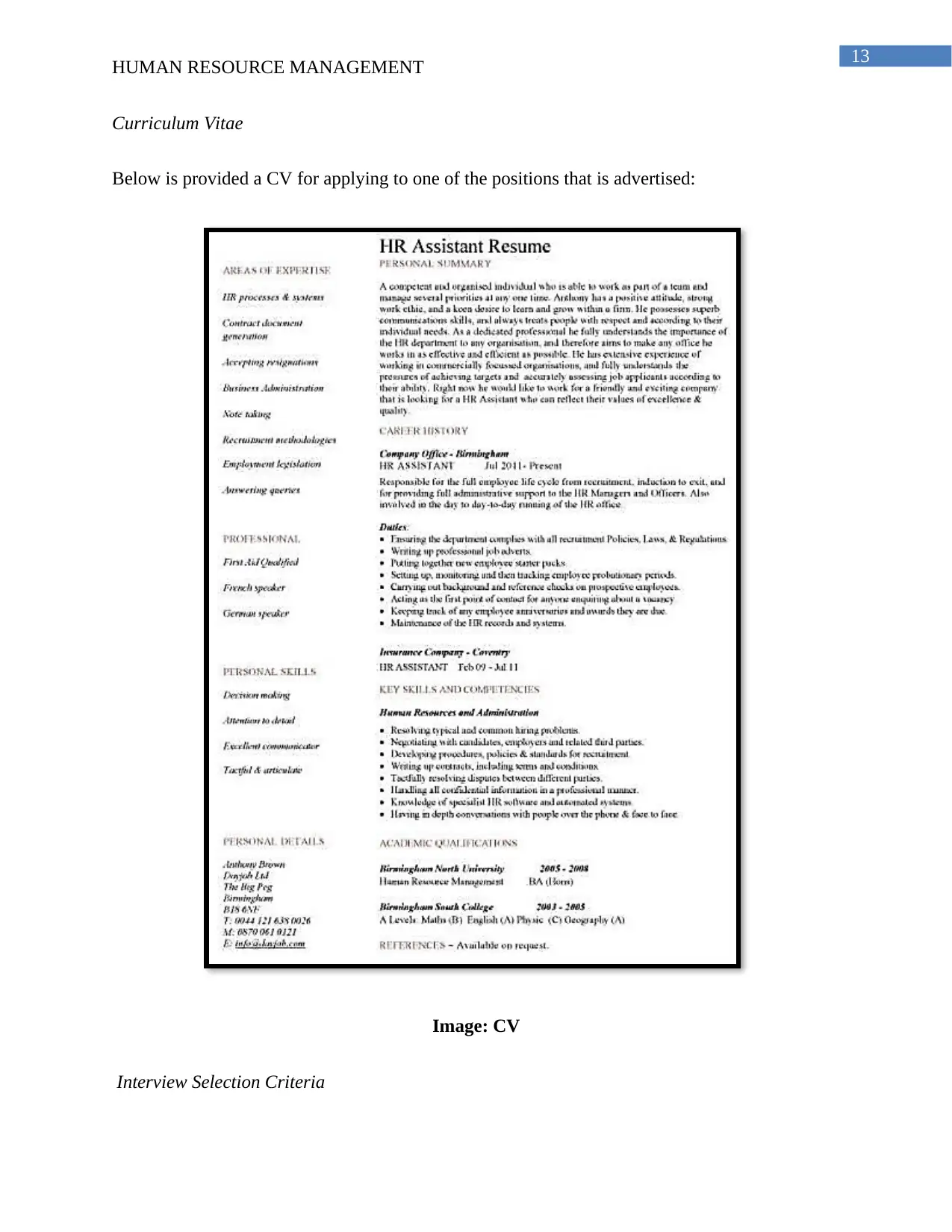
13
HUMAN RESOURCE MANAGEMENT
Curriculum Vitae
Below is provided a CV for applying to one of the positions that is advertised:
Image: CV
Interview Selection Criteria
HUMAN RESOURCE MANAGEMENT
Curriculum Vitae
Below is provided a CV for applying to one of the positions that is advertised:
Image: CV
Interview Selection Criteria
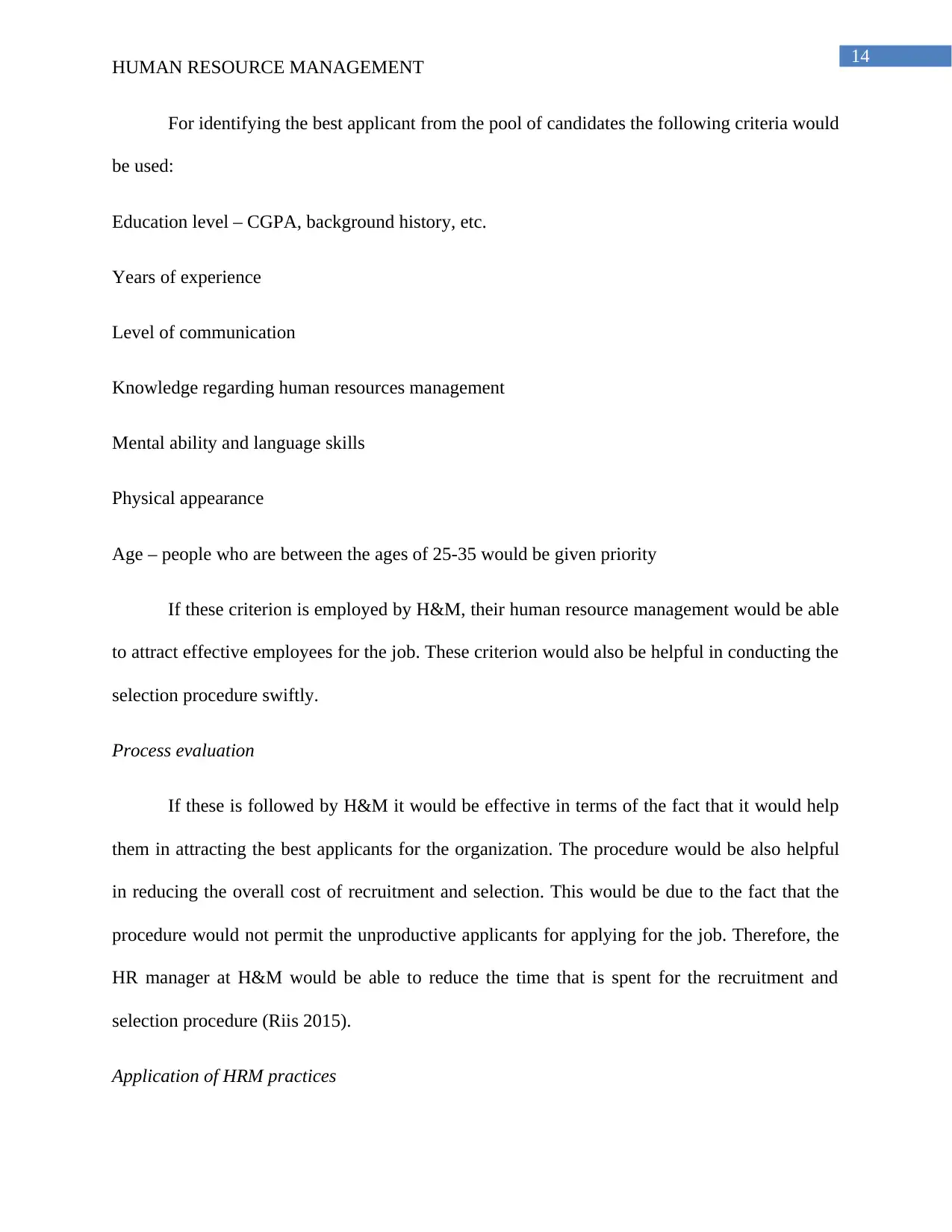
14
HUMAN RESOURCE MANAGEMENT
For identifying the best applicant from the pool of candidates the following criteria would
be used:
Education level – CGPA, background history, etc.
Years of experience
Level of communication
Knowledge regarding human resources management
Mental ability and language skills
Physical appearance
Age – people who are between the ages of 25-35 would be given priority
If these criterion is employed by H&M, their human resource management would be able
to attract effective employees for the job. These criterion would also be helpful in conducting the
selection procedure swiftly.
Process evaluation
If these is followed by H&M it would be effective in terms of the fact that it would help
them in attracting the best applicants for the organization. The procedure would be also helpful
in reducing the overall cost of recruitment and selection. This would be due to the fact that the
procedure would not permit the unproductive applicants for applying for the job. Therefore, the
HR manager at H&M would be able to reduce the time that is spent for the recruitment and
selection procedure (Riis 2015).
Application of HRM practices
HUMAN RESOURCE MANAGEMENT
For identifying the best applicant from the pool of candidates the following criteria would
be used:
Education level – CGPA, background history, etc.
Years of experience
Level of communication
Knowledge regarding human resources management
Mental ability and language skills
Physical appearance
Age – people who are between the ages of 25-35 would be given priority
If these criterion is employed by H&M, their human resource management would be able
to attract effective employees for the job. These criterion would also be helpful in conducting the
selection procedure swiftly.
Process evaluation
If these is followed by H&M it would be effective in terms of the fact that it would help
them in attracting the best applicants for the organization. The procedure would be also helpful
in reducing the overall cost of recruitment and selection. This would be due to the fact that the
procedure would not permit the unproductive applicants for applying for the job. Therefore, the
HR manager at H&M would be able to reduce the time that is spent for the recruitment and
selection procedure (Riis 2015).
Application of HRM practices
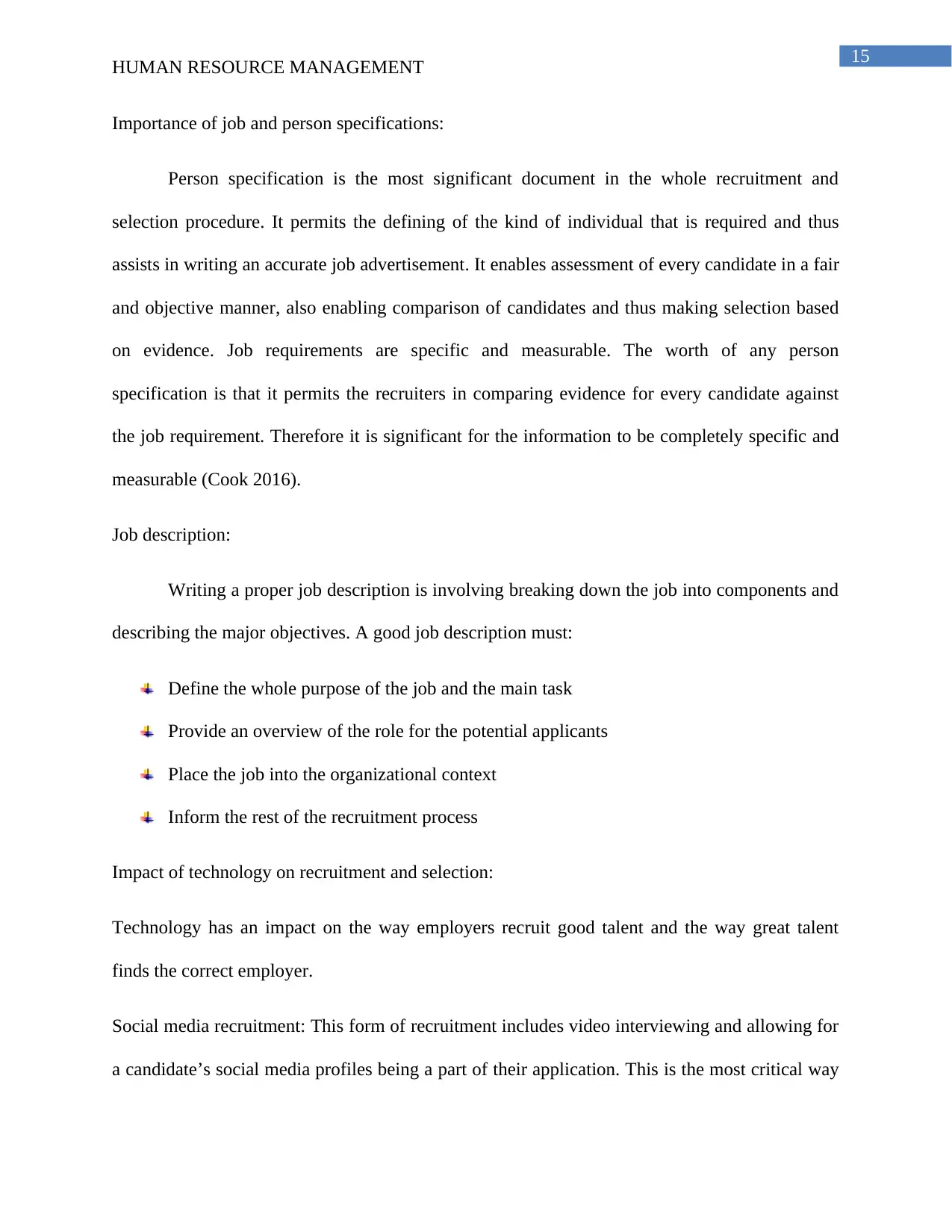
15
HUMAN RESOURCE MANAGEMENT
Importance of job and person specifications:
Person specification is the most significant document in the whole recruitment and
selection procedure. It permits the defining of the kind of individual that is required and thus
assists in writing an accurate job advertisement. It enables assessment of every candidate in a fair
and objective manner, also enabling comparison of candidates and thus making selection based
on evidence. Job requirements are specific and measurable. The worth of any person
specification is that it permits the recruiters in comparing evidence for every candidate against
the job requirement. Therefore it is significant for the information to be completely specific and
measurable (Cook 2016).
Job description:
Writing a proper job description is involving breaking down the job into components and
describing the major objectives. A good job description must:
Define the whole purpose of the job and the main task
Provide an overview of the role for the potential applicants
Place the job into the organizational context
Inform the rest of the recruitment process
Impact of technology on recruitment and selection:
Technology has an impact on the way employers recruit good talent and the way great talent
finds the correct employer.
Social media recruitment: This form of recruitment includes video interviewing and allowing for
a candidate’s social media profiles being a part of their application. This is the most critical way
HUMAN RESOURCE MANAGEMENT
Importance of job and person specifications:
Person specification is the most significant document in the whole recruitment and
selection procedure. It permits the defining of the kind of individual that is required and thus
assists in writing an accurate job advertisement. It enables assessment of every candidate in a fair
and objective manner, also enabling comparison of candidates and thus making selection based
on evidence. Job requirements are specific and measurable. The worth of any person
specification is that it permits the recruiters in comparing evidence for every candidate against
the job requirement. Therefore it is significant for the information to be completely specific and
measurable (Cook 2016).
Job description:
Writing a proper job description is involving breaking down the job into components and
describing the major objectives. A good job description must:
Define the whole purpose of the job and the main task
Provide an overview of the role for the potential applicants
Place the job into the organizational context
Inform the rest of the recruitment process
Impact of technology on recruitment and selection:
Technology has an impact on the way employers recruit good talent and the way great talent
finds the correct employer.
Social media recruitment: This form of recruitment includes video interviewing and allowing for
a candidate’s social media profiles being a part of their application. This is the most critical way
Secure Best Marks with AI Grader
Need help grading? Try our AI Grader for instant feedback on your assignments.
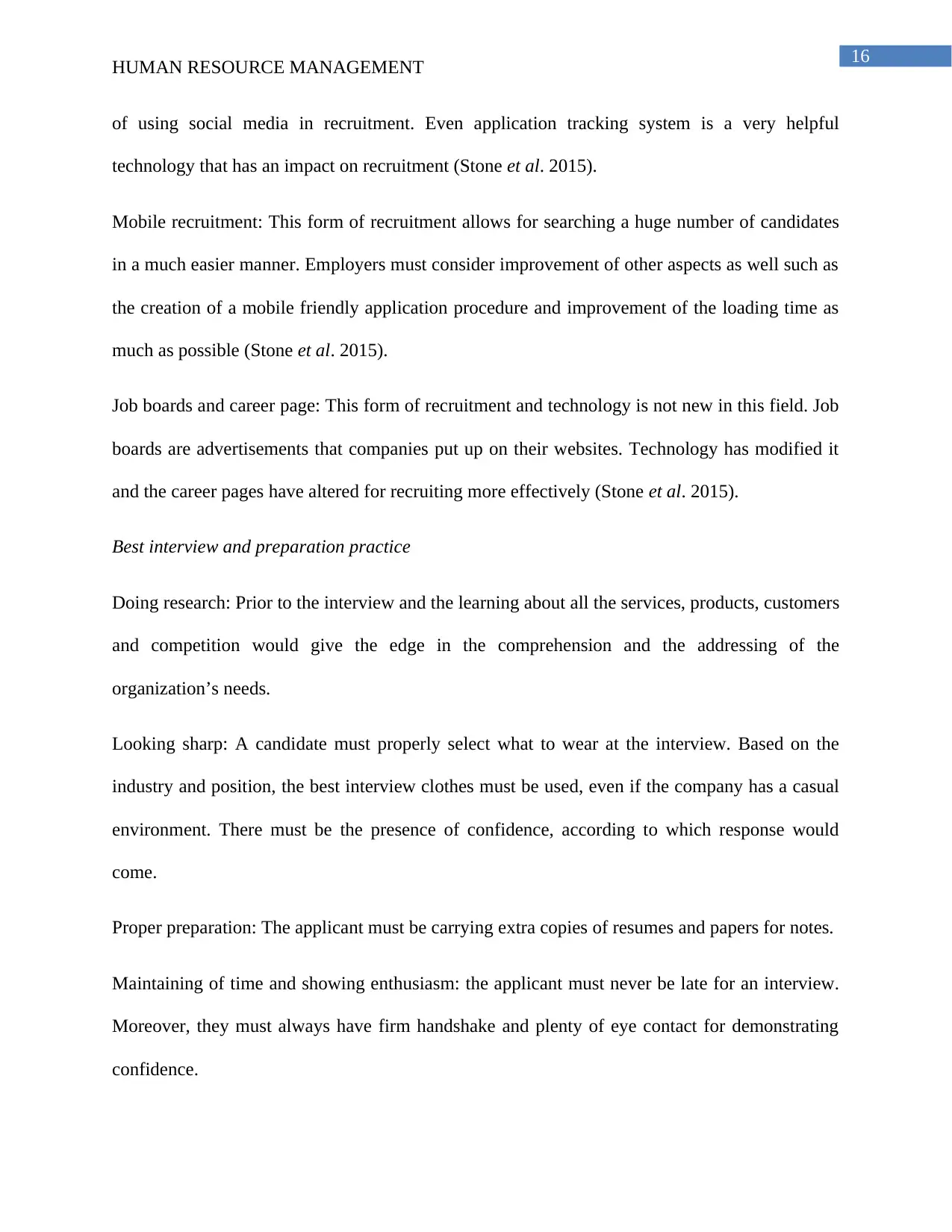
16
HUMAN RESOURCE MANAGEMENT
of using social media in recruitment. Even application tracking system is a very helpful
technology that has an impact on recruitment (Stone et al. 2015).
Mobile recruitment: This form of recruitment allows for searching a huge number of candidates
in a much easier manner. Employers must consider improvement of other aspects as well such as
the creation of a mobile friendly application procedure and improvement of the loading time as
much as possible (Stone et al. 2015).
Job boards and career page: This form of recruitment and technology is not new in this field. Job
boards are advertisements that companies put up on their websites. Technology has modified it
and the career pages have altered for recruiting more effectively (Stone et al. 2015).
Best interview and preparation practice
Doing research: Prior to the interview and the learning about all the services, products, customers
and competition would give the edge in the comprehension and the addressing of the
organization’s needs.
Looking sharp: A candidate must properly select what to wear at the interview. Based on the
industry and position, the best interview clothes must be used, even if the company has a casual
environment. There must be the presence of confidence, according to which response would
come.
Proper preparation: The applicant must be carrying extra copies of resumes and papers for notes.
Maintaining of time and showing enthusiasm: the applicant must never be late for an interview.
Moreover, they must always have firm handshake and plenty of eye contact for demonstrating
confidence.
HUMAN RESOURCE MANAGEMENT
of using social media in recruitment. Even application tracking system is a very helpful
technology that has an impact on recruitment (Stone et al. 2015).
Mobile recruitment: This form of recruitment allows for searching a huge number of candidates
in a much easier manner. Employers must consider improvement of other aspects as well such as
the creation of a mobile friendly application procedure and improvement of the loading time as
much as possible (Stone et al. 2015).
Job boards and career page: This form of recruitment and technology is not new in this field. Job
boards are advertisements that companies put up on their websites. Technology has modified it
and the career pages have altered for recruiting more effectively (Stone et al. 2015).
Best interview and preparation practice
Doing research: Prior to the interview and the learning about all the services, products, customers
and competition would give the edge in the comprehension and the addressing of the
organization’s needs.
Looking sharp: A candidate must properly select what to wear at the interview. Based on the
industry and position, the best interview clothes must be used, even if the company has a casual
environment. There must be the presence of confidence, according to which response would
come.
Proper preparation: The applicant must be carrying extra copies of resumes and papers for notes.
Maintaining of time and showing enthusiasm: the applicant must never be late for an interview.
Moreover, they must always have firm handshake and plenty of eye contact for demonstrating
confidence.

17
HUMAN RESOURCE MANAGEMENT
Conclusion
This report draws a line defining the different terms inside HRM and the impact it has on
the business of H&M. The human resource management at H&M has the capability of increasing
the profits by the reduction of the employee turnover. If H&M makes use of external recruitment
strategy, it would be able to hire creative and innovative employees for the organization.
Therefore, human resource management at H&M would be contributing in the effective brand
development. H&M must be ensuring effective human resource management at their workplace.
If not, the employer would not have the option of maintaining a productive and good relationship
with employees. This would in turn deteriorate and reduce the performance of the organization in
the market.
HUMAN RESOURCE MANAGEMENT
Conclusion
This report draws a line defining the different terms inside HRM and the impact it has on
the business of H&M. The human resource management at H&M has the capability of increasing
the profits by the reduction of the employee turnover. If H&M makes use of external recruitment
strategy, it would be able to hire creative and innovative employees for the organization.
Therefore, human resource management at H&M would be contributing in the effective brand
development. H&M must be ensuring effective human resource management at their workplace.
If not, the employer would not have the option of maintaining a productive and good relationship
with employees. This would in turn deteriorate and reduce the performance of the organization in
the market.

18
HUMAN RESOURCE MANAGEMENT
References
About.hm.com. 2017. H&M group | About. [online] Available at: http://about.hm.com/en/about-
us.html [Accessed 24 Nov. 2017].
Aragón, M.I.B., Jiménez, D.J. and Valle, R.S., 2014. Training and performance: The mediating
role of organizational learning. BRQ Business Research Quarterly, 17(3), pp.161-173.
Ash, R., Hodge, P. and Connell, P., 2013. The recruitment and selection of principals who
increase student learning. Education, 134(1), pp.94-100.
Aswathappa, K., 2013. Human resource management: Text and cases. Tata McGraw-Hill
Education.
Beardwell, J. and Thompson, A., 2014. Human resource management: a contemporary
approach. Pearson Education.
Blanpain, R. and Bisom-Rapp, S., 2014. Global Workplace: International and Comparative
Employment Law Cases and Materials. Wolters Kluwer Law & Business.
Bratton, J. and Gold, J., 2012. Human resource management: theory and practice. Palgrave
Macmillan.
Breaugh, J.A., 2017. to Recruitment. The Wiley Blackwell Handbook of the Psychology of
Recruitment, Selection and Employee Retention, p.12.
Buller, P.F. and McEvoy, G.M., 2012. Strategy, human resource management and performance:
Sharpening line of sight. Human resource management review, 22(1), pp.43-56.
HUMAN RESOURCE MANAGEMENT
References
About.hm.com. 2017. H&M group | About. [online] Available at: http://about.hm.com/en/about-
us.html [Accessed 24 Nov. 2017].
Aragón, M.I.B., Jiménez, D.J. and Valle, R.S., 2014. Training and performance: The mediating
role of organizational learning. BRQ Business Research Quarterly, 17(3), pp.161-173.
Ash, R., Hodge, P. and Connell, P., 2013. The recruitment and selection of principals who
increase student learning. Education, 134(1), pp.94-100.
Aswathappa, K., 2013. Human resource management: Text and cases. Tata McGraw-Hill
Education.
Beardwell, J. and Thompson, A., 2014. Human resource management: a contemporary
approach. Pearson Education.
Blanpain, R. and Bisom-Rapp, S., 2014. Global Workplace: International and Comparative
Employment Law Cases and Materials. Wolters Kluwer Law & Business.
Bratton, J. and Gold, J., 2012. Human resource management: theory and practice. Palgrave
Macmillan.
Breaugh, J.A., 2017. to Recruitment. The Wiley Blackwell Handbook of the Psychology of
Recruitment, Selection and Employee Retention, p.12.
Buller, P.F. and McEvoy, G.M., 2012. Strategy, human resource management and performance:
Sharpening line of sight. Human resource management review, 22(1), pp.43-56.
Paraphrase This Document
Need a fresh take? Get an instant paraphrase of this document with our AI Paraphraser
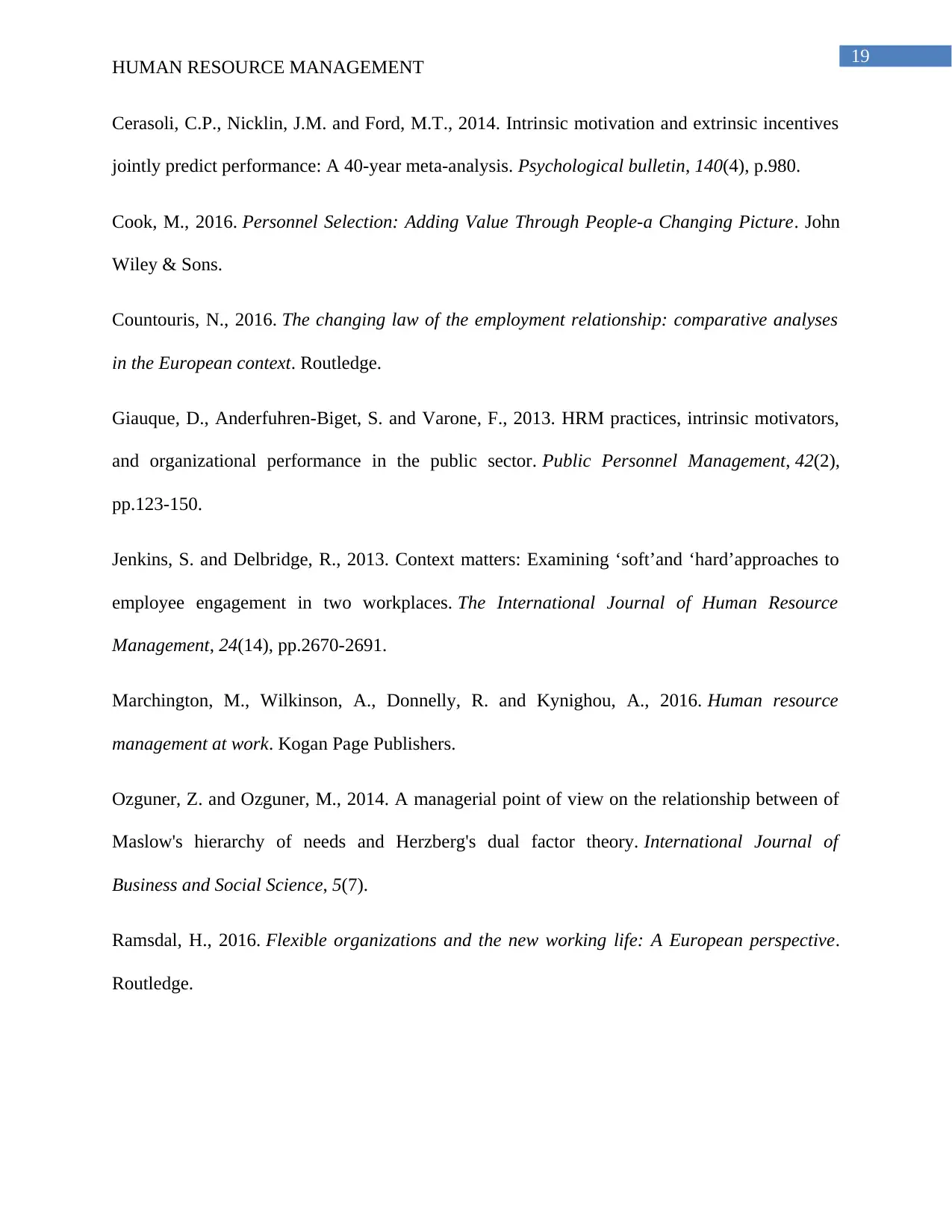
19
HUMAN RESOURCE MANAGEMENT
Cerasoli, C.P., Nicklin, J.M. and Ford, M.T., 2014. Intrinsic motivation and extrinsic incentives
jointly predict performance: A 40-year meta-analysis. Psychological bulletin, 140(4), p.980.
Cook, M., 2016. Personnel Selection: Adding Value Through People-a Changing Picture. John
Wiley & Sons.
Countouris, N., 2016. The changing law of the employment relationship: comparative analyses
in the European context. Routledge.
Giauque, D., Anderfuhren-Biget, S. and Varone, F., 2013. HRM practices, intrinsic motivators,
and organizational performance in the public sector. Public Personnel Management, 42(2),
pp.123-150.
Jenkins, S. and Delbridge, R., 2013. Context matters: Examining ‘soft’and ‘hard’approaches to
employee engagement in two workplaces. The International Journal of Human Resource
Management, 24(14), pp.2670-2691.
Marchington, M., Wilkinson, A., Donnelly, R. and Kynighou, A., 2016. Human resource
management at work. Kogan Page Publishers.
Ozguner, Z. and Ozguner, M., 2014. A managerial point of view on the relationship between of
Maslow's hierarchy of needs and Herzberg's dual factor theory. International Journal of
Business and Social Science, 5(7).
Ramsdal, H., 2016. Flexible organizations and the new working life: A European perspective.
Routledge.
HUMAN RESOURCE MANAGEMENT
Cerasoli, C.P., Nicklin, J.M. and Ford, M.T., 2014. Intrinsic motivation and extrinsic incentives
jointly predict performance: A 40-year meta-analysis. Psychological bulletin, 140(4), p.980.
Cook, M., 2016. Personnel Selection: Adding Value Through People-a Changing Picture. John
Wiley & Sons.
Countouris, N., 2016. The changing law of the employment relationship: comparative analyses
in the European context. Routledge.
Giauque, D., Anderfuhren-Biget, S. and Varone, F., 2013. HRM practices, intrinsic motivators,
and organizational performance in the public sector. Public Personnel Management, 42(2),
pp.123-150.
Jenkins, S. and Delbridge, R., 2013. Context matters: Examining ‘soft’and ‘hard’approaches to
employee engagement in two workplaces. The International Journal of Human Resource
Management, 24(14), pp.2670-2691.
Marchington, M., Wilkinson, A., Donnelly, R. and Kynighou, A., 2016. Human resource
management at work. Kogan Page Publishers.
Ozguner, Z. and Ozguner, M., 2014. A managerial point of view on the relationship between of
Maslow's hierarchy of needs and Herzberg's dual factor theory. International Journal of
Business and Social Science, 5(7).
Ramsdal, H., 2016. Flexible organizations and the new working life: A European perspective.
Routledge.

20
HUMAN RESOURCE MANAGEMENT
Riis, A., Jensen, C.E., Maindal, H.T., Bro, F. and Jensen, M.B., 2015. Recruiting medical groups
for research process evaluation of a recruitment procedure in general practice. In 2015 Nordic
Conference on Implementation of Evidence-Based Practice. Nyt Nordisk Forlag Arnold Busck.
Salau, O.P., Falola, H.O. and Akinbode, J., 2014. Induction and staff attitude towards retention
and organizational effectiveness. IOSR Journal of Business and Management (IOSR-
JBM), 16(4), pp.47-52.
Shields, J., Brown, M., Kaine, S., Dolle-Samuel, C., North-Samardzic, A., McLean, P., Johns,
R., O'Leary, P., Robinson, J. and Plimmer, G., 2015. Managing Employee Performance &
Reward: Concepts, Practices, Strategies. Cambridge University Press.
Stone, D.L., Deadrick, D.L., Lukaszewski, K.M. and Johnson, R., 2015. The influence of
technology on the future of human resource management. Human Resource Management
Review, 25(2), pp.216-231.
Sung, S.Y. and Choi, J.N., 2014. Do organizations spend wisely on employees? Effects of
training and development investments on learning and innovation in organizations. Journal of
organizational behavior, 35(3), pp.393-412.
Wilton, N., 2016. An introduction to human resource management. Sage.
Zhang, M.M., Bartram, T., McNeil, N. and Dowling, P.J., 2015. Towards a research agenda on
the sustainable and socially responsible management of agency workers through a flexicurity
model of HRM. Journal of Business Ethics, 127(3), pp.513-523.
HUMAN RESOURCE MANAGEMENT
Riis, A., Jensen, C.E., Maindal, H.T., Bro, F. and Jensen, M.B., 2015. Recruiting medical groups
for research process evaluation of a recruitment procedure in general practice. In 2015 Nordic
Conference on Implementation of Evidence-Based Practice. Nyt Nordisk Forlag Arnold Busck.
Salau, O.P., Falola, H.O. and Akinbode, J., 2014. Induction and staff attitude towards retention
and organizational effectiveness. IOSR Journal of Business and Management (IOSR-
JBM), 16(4), pp.47-52.
Shields, J., Brown, M., Kaine, S., Dolle-Samuel, C., North-Samardzic, A., McLean, P., Johns,
R., O'Leary, P., Robinson, J. and Plimmer, G., 2015. Managing Employee Performance &
Reward: Concepts, Practices, Strategies. Cambridge University Press.
Stone, D.L., Deadrick, D.L., Lukaszewski, K.M. and Johnson, R., 2015. The influence of
technology on the future of human resource management. Human Resource Management
Review, 25(2), pp.216-231.
Sung, S.Y. and Choi, J.N., 2014. Do organizations spend wisely on employees? Effects of
training and development investments on learning and innovation in organizations. Journal of
organizational behavior, 35(3), pp.393-412.
Wilton, N., 2016. An introduction to human resource management. Sage.
Zhang, M.M., Bartram, T., McNeil, N. and Dowling, P.J., 2015. Towards a research agenda on
the sustainable and socially responsible management of agency workers through a flexicurity
model of HRM. Journal of Business Ethics, 127(3), pp.513-523.
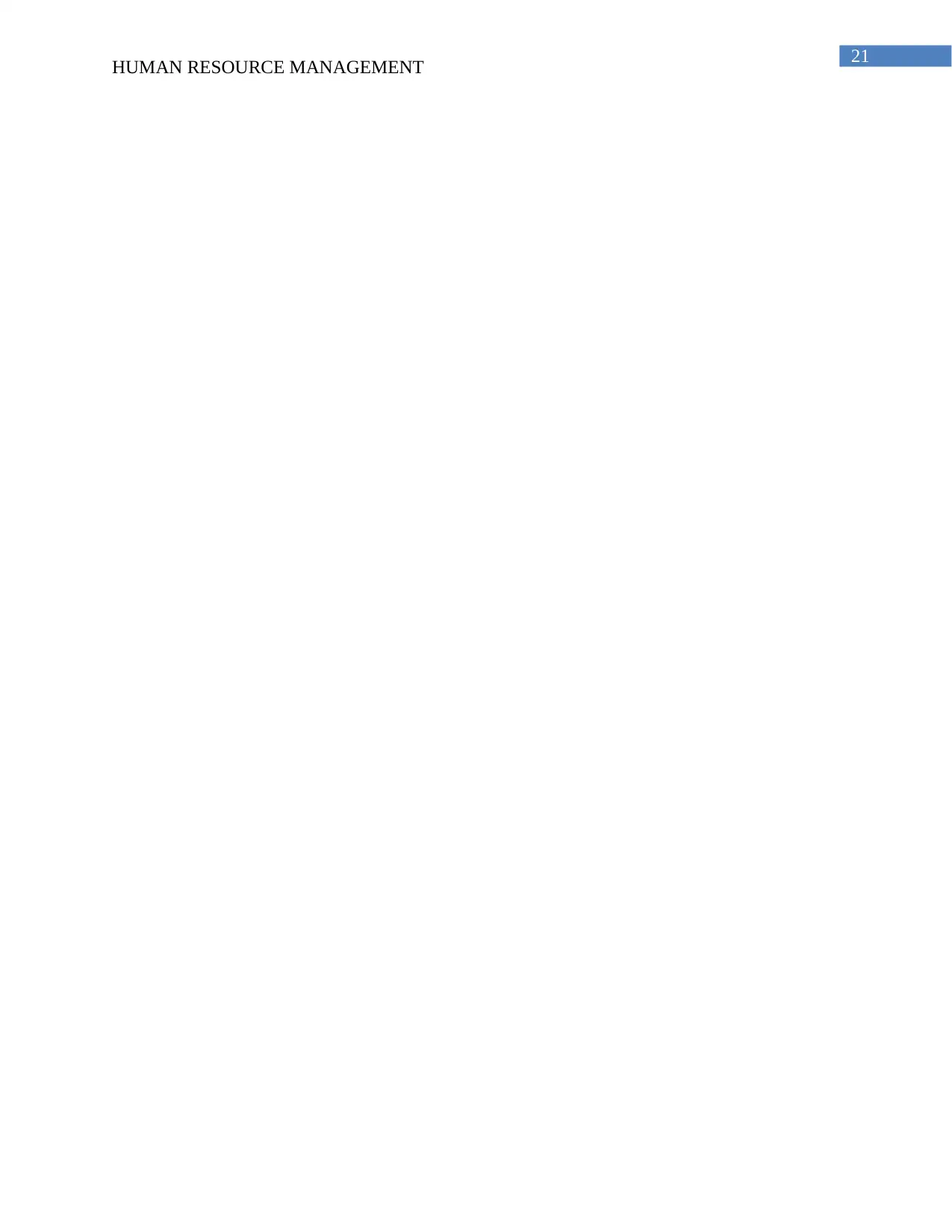
21
HUMAN RESOURCE MANAGEMENT
HUMAN RESOURCE MANAGEMENT
1 out of 22
Your All-in-One AI-Powered Toolkit for Academic Success.
+13062052269
info@desklib.com
Available 24*7 on WhatsApp / Email
![[object Object]](/_next/static/media/star-bottom.7253800d.svg)
Unlock your academic potential
© 2024 | Zucol Services PVT LTD | All rights reserved.





